Weekly Recap
Last week, global markets experienced increased volatility after President Trump imposed a 10% universal trade tariff and reciprocal tariffs on many individual countries. China was hit with a 34% tariff on top of the already 20% tariff, bringing total tariffs to 54% on the world’s second-largest economy. Other Southeast Asian countries, such as Vietnam (46%), Indonesia (32%), and Thailand (36%), were also hard hit. Meanwhile, the European Union was slapped with tariffs of 20% and Japan 24%
China announced reciprocal tariffs of 34% on the US, fuelling fears of a full-on trade war between the world’s largest economies. Whilst the European Union hasn’t retaliated yet, it has warned that it would retaliate if talks in Washington do not progress. The Hang Seng fell 10% on Monday.
The S&P 500 fell 9% last week, while the Nasdaq tumbled 10%, entering a bear market marked by a 20% decline from its recent peak.

Stocks are falling sharply at the start of the week as President Trump holds firm on his tariffs and the market frets over the possibility of a recession. The market is pricing in four 25-basis-point rate cuts from the Fed this year, up from two a few weeks ago. The chances of a recession have risen sharply, with J.P. Morgan now forecasting a 60% likelihood of a recession.
While there are several key market events, these could be overshadowed by concerns about Trump’s trade tariffs.
FOMC minutes
At the March meeting, the Fed left interest rates unchanged, as expected, and maintained its forecasts for two rate cuts in 2025. Policy makers noted that economic activity had continued to expand at a solid pace but also cited increased uncertainty and inflation as inflation risks remained somewhat elevated. The central bank lowered its growth projections for 2025 and 2026, while also increasing its unemployment rate and PCE inflation forecasts. The Fed also slowed down its balance sheet runoff in line with previous guidance. The dot plot continued to show that FMC members were divided on the number of cuts this year, but the median remained at two cuts, although fewer policymakers were convinced. Fed chair Powell stressed a wait-and-see approach. However, the meeting took place before Trump’s trade tariffs, so it may be outdated and overshadowed by concerns about trade tariffs and the recession.
The S&P 500 has fallen sharply; however, it is currently very oversold, so sellers should be cautious.
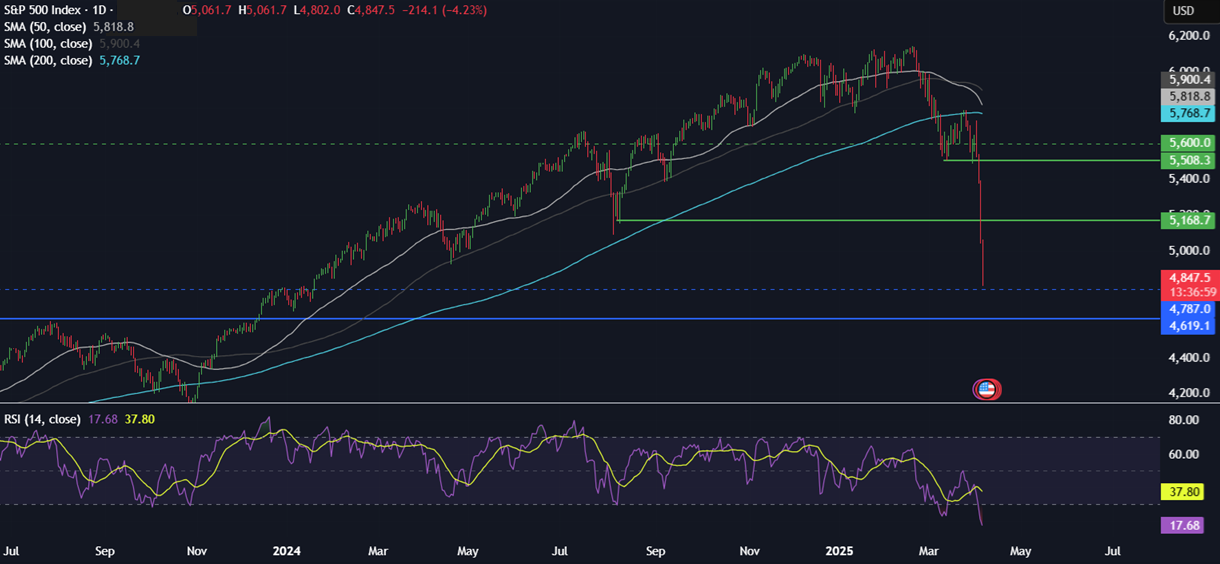
China CPI (Thursday)
Inflation data for March will be released on Thursday, and high-frequency price data suggest that the CPI remains soft in March, with headline CPI expected to remain around 0% on a monthly basis and rise to 0.1% annually. Meanwhile, PPI, which measures inflation at the wholesale level, is expected to remain in negative territory for the 30th consecutive month as the majority of input costs continue to fall.
This data could be considered stale given that it was from prior to Trump’s trade tariff announcement and China’s retaliation on US imports.
The Chinese economy is experiencing a challenging period and has relied on exports to sustain itself amid a slump in the property sector, weak domestic demand, and deflationary pressures. Goldman Sachs estimates that US tariffs will reduce China’s GDP growth by 1%.
AUD is considered a proxy for China. AUD/USD has fallen below 0.60 to its lowest level since 2020 the Covid pandemic.
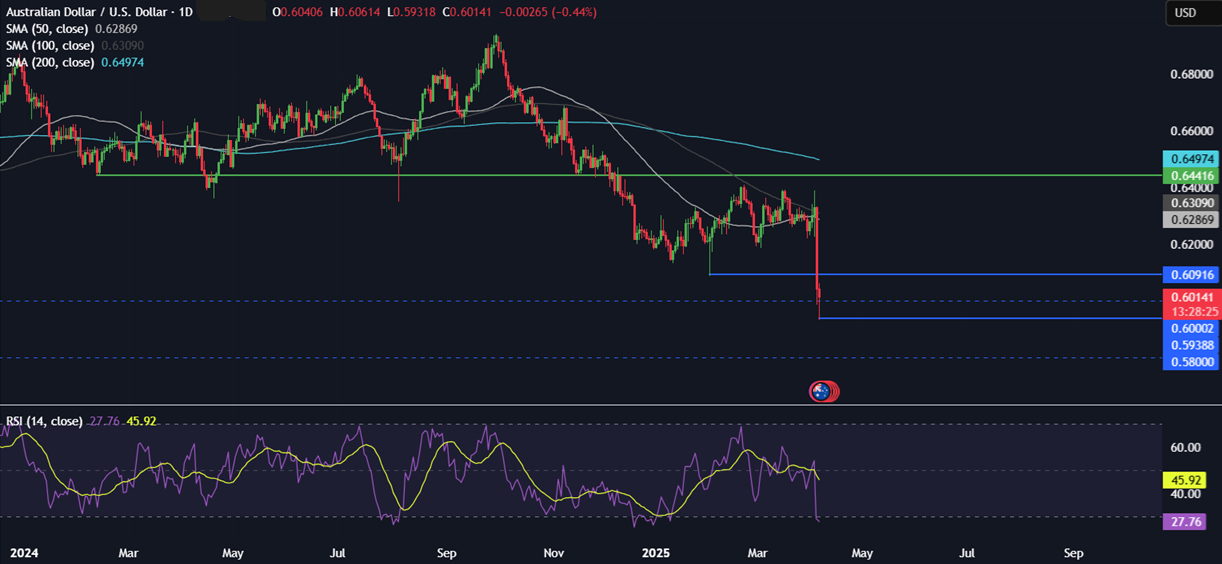
US CPI (Thursday)
US inflation is expected to ease to 2.6% annually in March, down from 2.8% in February, whilst core CPI is expected to cool to 3%, down from 3.1%. Meanwhile, on Friday, PPI is expected to come in at 3%, down from 3.2% in February.
The data comes as trump tariffs have changed the outlook for US inflation, which is expected to rise if importers pass on higher costs to consumers. Some investment banks have pointed to inflation increasing to 4.5 or 5% on the back of rising price pressures owing to Trump’s trade tariffs. With this in mind, should March inflation come in higher than expected, the outlook could deteriorate further. Implementing trade tariffs on top of hot inflation data could fuel a phase of stagflation. This could actually cause the US dollar to fall further and also pull US stocks lower.
USD/JPY trades around a 6-month low but is not oversold. Hot US inflation could pull the pair below 145.00.
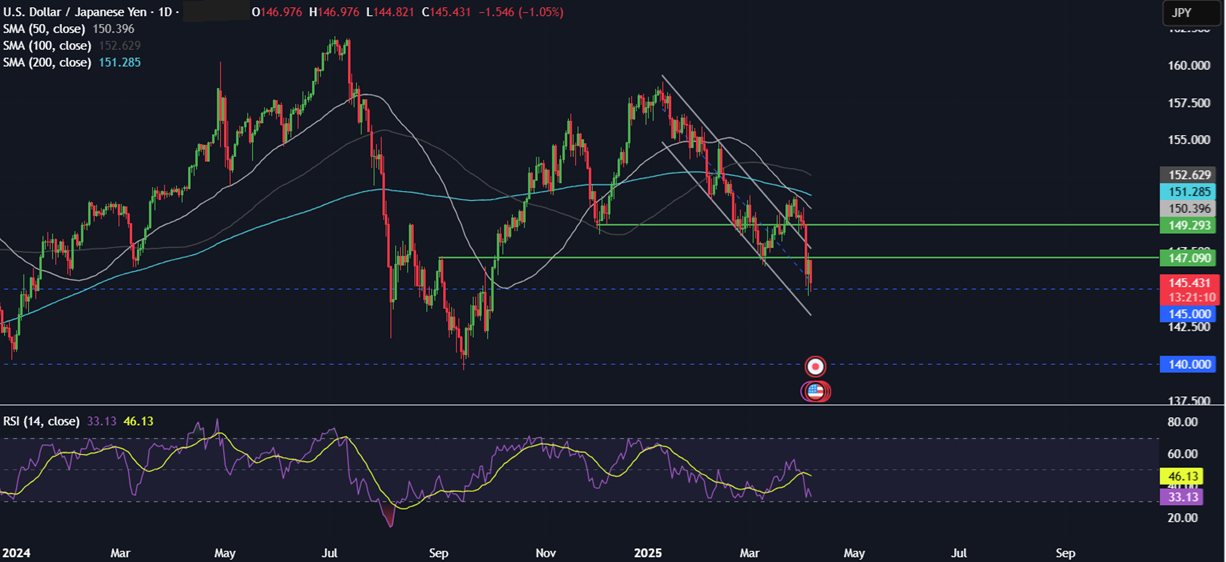
U.S. consumer confidence fell sharply in the previous month, down 11.9% from February and 20.8% from a year ago. Consumer sentiment could deteriorate further amid concerns that inflation is intensifying and fears of a recession are growing. Weak consumer sentiment could pull US stocks lower.
UK GDP (Friday)
The month-to-month GDP for February is expected to increase to 0.1% from the -0.1% decline in January and a 0.4% increase in December. Meanwhile, the three-month rate is expected to rise to 0.4%, up from 0.2%. January’s came after surprising me with a strong December expansion of 0.4%, which made the economy seem stronger than it is. The growth outlook is expected to remain weak, but it is unlikely to have a significant impact on the Bank of England, which remains firmly focused on its inflation mandate. Currently, the market expects a 25-basis-point reduction in June, which is already fully priced in, and 75 basis points of cuts this year. That said, the UK economy could be vulnerable to a sharper slowdown, despite the relatively modest 10% tariffs from Trump. This is because it is susceptible to a slowdown in global growth.
GBP/USD has fallen towards 1.29, owing to weak global growth and despite a sharp decline in the USD.
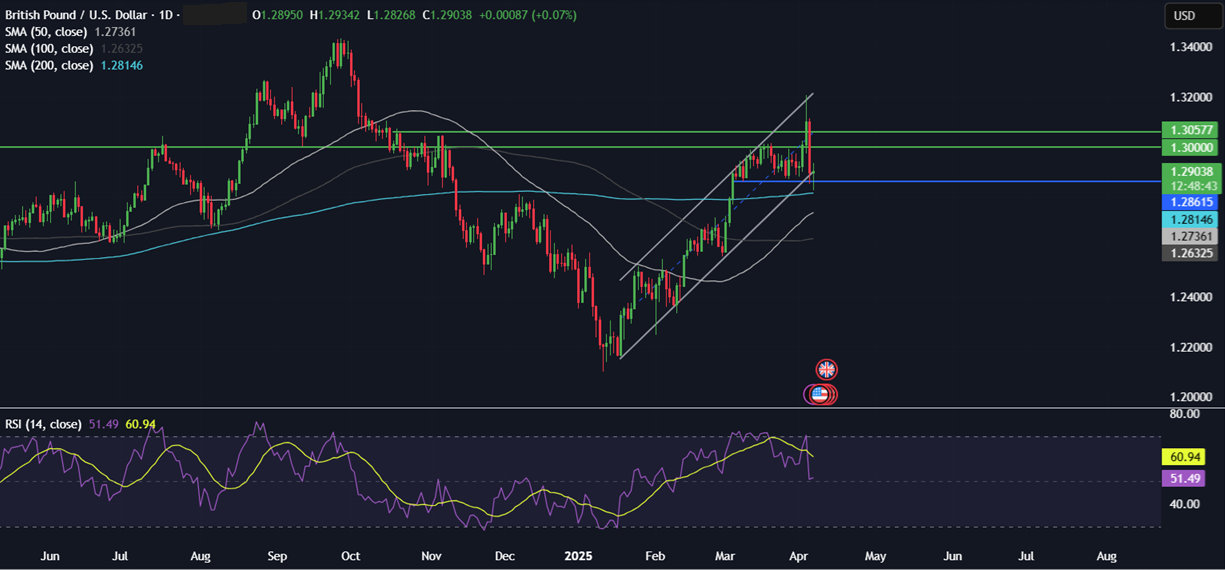
US earnings season (Friday)
US earnings season kicks off with the banking sector, led by J.P. Morgan and Wells Fargo, on Friday, as well as the Wells Fargo Group.
Guidance will be watched closely, given that Trump’s sweeping tariffs could slow dealmaking and loan demand. Banks have been hard hit by fears of a recession and a decline in consumer spending. The market often sells banks or any bad news, and that’s precisely what we’ve been seeing, given their economic sensitivity. The banking sector is closely tied to the macroeconomic environment, so guidance will be closely watched, with recession warnings expected to impact broader confidence.
The Dow Jones trades at its lowest level since December 2023. The RSI is very oversold, so sellers should be cautious about chasing losses lower at this point.
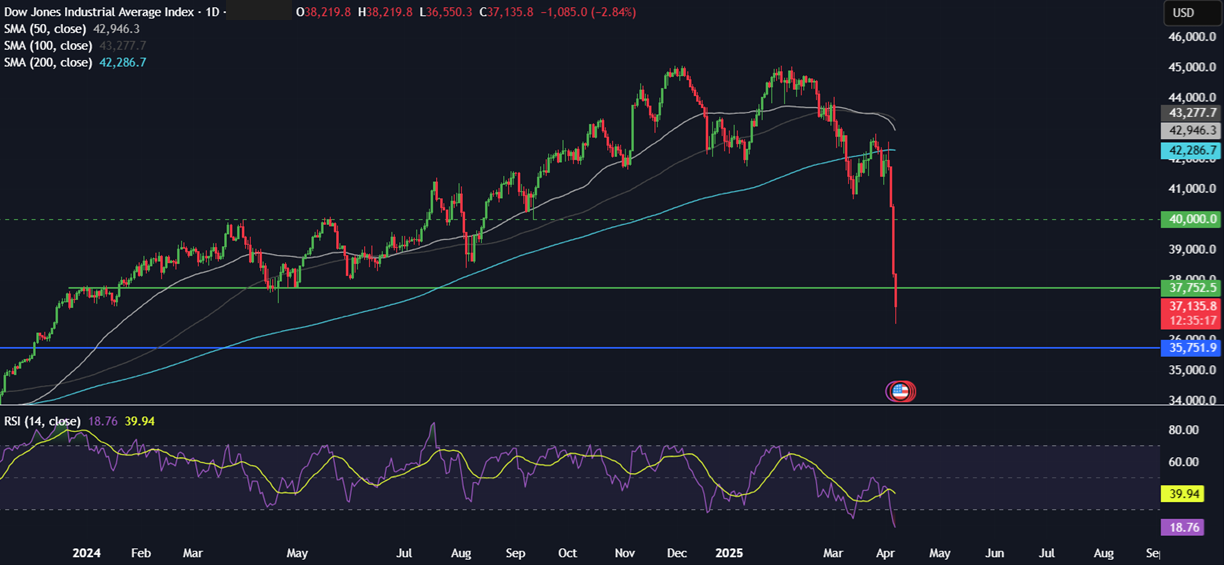
The content provided here is for informational purposes only. It is not intended as personal investment advice and does not constitute a solicitation or invitation to engage in any financial transactions, investments, or related activities. Past performance is not a reliable indicator of future results.
The financial products offered by the Company are complex and come with a high risk of losing money rapidly due to leverage. These products may not be suitable for all investors. Before engaging, you should consider whether you understand how these leveraged products work and whether you can afford the high risk of losing your money.
The Company does not accept clients from the Restricted Jurisdictions as indicated in our website/ T&C. Some services or products may not be available in your jurisdiction.
The applicable legal entity and its respective products and services depend on the client’s country of residence and the entity with which the client has established a contractual relationship during registration.




